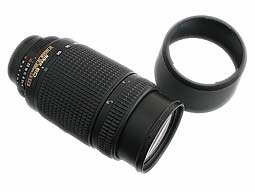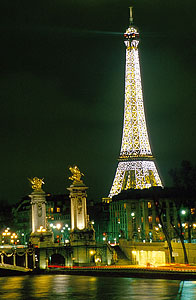The
Basics
This Nikkor has
a variable maximum aperture that ranges from f/4 at 70mm to f/5.6 at 300mm.
The minimum aperture is f/32 at 70mm. Small colored dots are used to indicate
the aperture for 70mm versus the aperture for 300mm. Focusing can be as close
as 5 feet (1.5) at any zoom setting; there is no macro mode. No infrared focusing
mark is provided. The front element rotates during focus (and less so during
zooming), making use of a polarizer a bit of a chore. The D in the name means
that focus distance is used in flash metering calculations by the camera.
The ED indicates that twoof the elements are made of Nikon's unique extra-low
dispersion glass, which helps focus color information at the same plane, especially
at longer focal lengths. As with all ED lenses, the lens focuses past infinity
under normal temperature conditions.
The manual zoom
and focus rings are separate, and easily distinguished. The front focus ring
is wide and easy to find compared to some AF lenses. At the front of the lens,
you'll be screwing in 62mm accessories (Nikon's medium standard, shared by
many Nikkor lenses). If you have to know, there are 13 elements in 9groups,
a bit on the complex side, though typical of telephoto zooms.
The lens comes
with the HB-15 hood. The size is relatively small at 70mm, so the lens fits
nicely into even small camera cases, though when zoomed in to 300mm the lens
does extend several inches. Build quality is adequate and features a sturdy
polycarbonate body. Nikon does not supply a tripod mount for this lens, but
since it isn't very heavy, this isn't really an issue except at 300mm and
slowish shutter speeds. Because of the light weight and compact body, this
is lens that begs to be used handheld.
Handling
The focus and
zoom rings are easily distinguished. The zoom ring has a decent feel, almost
the equal of the professional lenses. The focus ring isn't quite as good,
as it has the usual autofocus "looseness," but it is better than
many recent lower-priced Nikkors. Both the focus and zoom go from one extreme
to the other in slightly less than a quarter of a turn, which seems to be
Nikon's new standard. The zoom doesn't tend to creep, even when you zoom all
the way out and set the lens down on its front (with all the weight behind
it). That's a far cry from the old one-touch zooms that creeped if you looked
at them cross-eyed, and even better performance than some of the more recent
two-touch zooms.
The aperture
ring has solid click stops and a decent feel. The aperture lock is a little
further from the body than on some Nikkors, making it easier to get to (you
still need a good fingernail to catch it, though).
The front element
is not recessed, as it is on some telephotos, though the front element is
reasonably flat, so you won't accidentally touch it when you reach around
the front. The rear element is well recessed at all zoom settings, which could
prove to be a problem if you need to clean it regularly.
The supplied
HB-15 lens hood bayonets onto the front piece, and is made of cheap, slightly
flexible, plastic. Unfortunately, there is no indicators to help you line
it up with the lens, so you basically have to mount it be feel. If you can
get the lens cap off with the hood mounted, you've got smaller fingers than
I do (I'm a medium glove size). You can reverse the hood on the lens for storage,
which is a welcome touch.
Here's the weird
part: While there's an indicator line to show you what focal length the lens
is set at, there is no focus point indicator. Yes, there's a distance scale,
but there's no nearby indicator to tell you at what distance you're focused
(you can look back to the zoom indicator, but that's several inches back on
the lens--you won't be setting precise distances without a straightedge).
Performance
I was expecting
to be disappointed with this lens. Other reviews I'd read had a decidedly
ho-hum reaction to the 70-300's performance. I suspect the ED elements had
them expecting state-of-the-art optics, something that would challenge the
80-200mm f/2.8.
First, the good
news: in terms of Nikon's consumer offerings, this lens is at the top of the
heap. I'd call it a distinct improvement on the 75-300mm it replaced. From
its widest setting to about midrange, it performs well even at f/5.6, with
results at f/8 and f/11 virtually indistinguishable from the considerably
more expensive 80-200 f/2.8, except, perhaps, at the very corners. On a D1
I wouldn't have any qualms at using this lens wide open at any zoom setting
between 70-200mm. Distortion was visible at the telephoto end, but not enough
for me to worry about in the types of photography I do; if you're into using
telephotos for architectural work, well, you're going to see enough pinbarrel
at the 300mm end to keep you from smiling.
On the down side,
the results at f/22 and f/32, as is usual for telephotos, is not particularly
good. And as you near 300mm, you'll see some softness at all apertures, and
the edges are distinctly soft. You can keep both problems reasonably in check
by using f/8 or f/11. Chromatic aberration is distinctly present in the sample
image, above, though reasonably well controlled (e.g., while present, other
telephoto zooms I've used show more).
Contrast is good,
though not as good as the 80-200mm f/2.8. Contrast appears better than the
other Nikkor telephoto zooms I've used, though I haven't used this lens in
enough different situations to make that a blanket statement. Autofocus has
been quick and sure in almost every situation I've used it in. Even in the
Paris shot, above, the lens didn't hesitate (those lights are all blinking,
by the way, at different intervals, so it isn't as high contrast a situation
as you'd think).
Overall, I am
quite pleased with the lens, especially on a D1. I'd rank this zoom by itself
midway between the other consumer telephoto zooms and the top-of-the-line
AF-S 80-200mm f/2.8.
Drawbacks
- No
depth of field scale. In fact, it's hard to figure out the
exact focus distance due to the way markings are done.
- No
tripod mount. Not a big problem unless you shoot at 300mm
at slower shutter speeds on a tripod. Actually, when mounted on an F5, I
wouldn't want a tripod mount at all, since this lens is so light the weight
of the camera body would be a problem. But with light camera bodies, such
as the N65/F65 or N80/F80, be careful at 300mm and shutter speeds under
1/125.
- Softness
at 300mm. You probably won't notice the softness as much as the
loss of contrast, especially if you compare results obtained with this lens
versus, say, the 300mm f/4. Still, in a pinch,
the 300mm this lens produces is quite usable, especially at f/8 and f/11.


